| Author |
Message |
|
Timo Nieminen
|
 Posted: Fri 25 Apr, 2014 12:48 pm Post subject: Show us your dao Posted: Fri 25 Apr, 2014 12:48 pm Post subject: Show us your dao |
 |
|
"Dao", 刀, means a single-edged blade. It's used to refer to everything from scalpels through to large single-edged polearms, including, of course, single-edged swords somewhere in the middle. Often preceded by an adjective for more precision, sometimes yielding a precise narrow term (e.g., 柳葉刀, liuyedao, or "willow leaf sword") and sometimes remaining very general (e.g., 大刀, dadao, or "big sword", which can refer to a "full-size" one-handed sword, the short two-handed sword we usually mean, and large polearms.
"Dou" in Cantonese, "do" in Korean, and "to" and "katana" in Japanese. Yes, katana are dao, though common enough so they might want their own "Show us your katana" thread.
For more information on dao in general: http://en.wikipedia.org/wiki/Dao_(sword)
And specific types: http://en.wikipedia.org/wiki/Category:Chinese_swords
Bring on the dao!
"In addition to being efficient, all pole arms were quite nice to look at." - Cherney Berg, A hideous history of weapons, Collier 1963.
|
|
   |
 |
|
Timo Nieminen
|
 Posted: Fri 25 Apr, 2014 1:03 pm Post subject: Posted: Fri 25 Apr, 2014 1:03 pm Post subject: |
 |
|
A pair of military-style reproductions. The top one is good quality, with brass fittings, good blade (my son hit the steel base of my cutting stand, cutting into it, and the damage to the edge was very minor), tastefully done folded blade. The bottom one is a cheap dao (from Zhisword), zinc-aluminium alloy fittings, fittings are overdecorated, but the sword has better weight and balance.
Top: 1225g, PoB 7".
Bottom: 1095g, PoB 4.5"
Iron fittings would be authentic. The tunkou (i.e., the equivalent of the habaki) on the top sword is very thin - should be thicker. The scabbard should be covered with leather (or maybe ray/fish skin). Otherwise, fair representive repros of late Qing military dao.
 Attachment: 85.97 KB Attachment: 85.97 KB
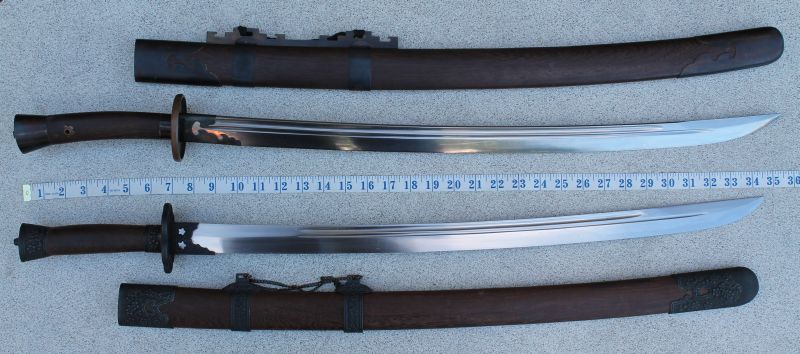
Repro military-style dao
"In addition to being efficient, all pole arms were quite nice to look at." - Cherney Berg, A hideous history of weapons, Collier 1963.
|
|
   |
 |
|
Timo Nieminen
|
 Posted: Fri 25 Apr, 2014 1:08 pm Post subject: Posted: Fri 25 Apr, 2014 1:08 pm Post subject: |
 |
|
A pair of antique military-style dao. Just like the repros above, here we have a heavy one and a light one. The top one is a classical late Qing cavalry sword (iron fittings, leather covered scabbard), 1210g, PoB at 8". Probably mid-late 19th century.
The bottom one might be civilian (or militia). 830g, PoB at 7". Probably mid-late 19th century.
 Attachment: 77.65 KB Attachment: 77.65 KB
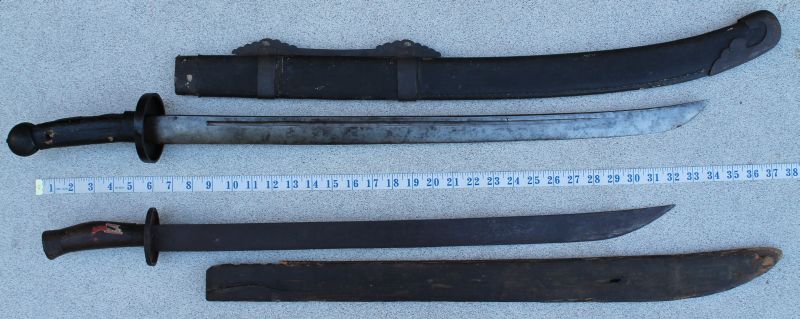
Antique military-style dao
"In addition to being efficient, all pole arms were quite nice to look at." - Cherney Berg, A hideous history of weapons, Collier 1963.
|
|
   |
 |
|
Timo Nieminen
|
 Posted: Fri 25 Apr, 2014 1:35 pm Post subject: Posted: Fri 25 Apr, 2014 1:35 pm Post subject: |
 |
|
A pair of lighter dao. The bottom one has a nice well-made blade, guard is very thin. 620g and PoB at 7". Late 19th century?
The top one is a fancy court sword. Jade guard, square-style hilt and scabbard. Rather light and delicate at 520g and 5.5". A guard officer could wear it around the palace all day without getting tired. There are inscriptions on both sides of the blade. On the first side, "廂紅衛兵", room/wing-red-guard. On the other, "光緒", Guangxu, the Emperor of the time (reigned 1875-1908), and the date, October 1891. So looks like a palace guard officer's sword.
 Attachment: 80.97 KB Attachment: 80.97 KB
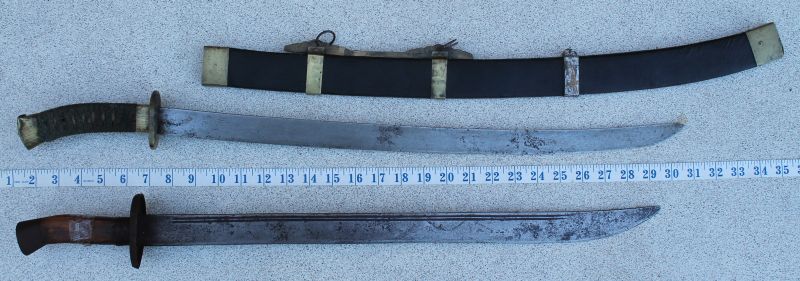
Dao
 Attachment: 43.7 KB Attachment: 43.7 KB
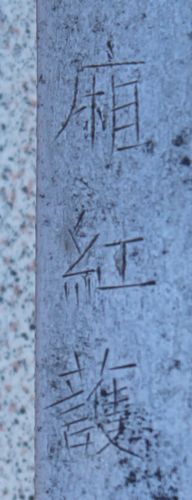
Inscription
 Attachment: 44.83 KB Attachment: 44.83 KB

Inscription
"In addition to being efficient, all pole arms were quite nice to look at." - Cherney Berg, A hideous history of weapons, Collier 1963.
|
|
   |
 |
|
Timo Nieminen
|
 Posted: Fri 25 Apr, 2014 1:50 pm Post subject: Posted: Fri 25 Apr, 2014 1:50 pm Post subject: |
 |
|
This one appeared in the jian thread. Since it's part jian, part dao, it can appear here too.
This is a steel sword in the pattern of a bronze dao. This is double-edged all the way, so technically, it's a jian with an asymmetric tip. But it's a steel copy of a bronze dao (i.e., single-edged sword); the back edge on the originals were a couple of millimeters thick, rather than sharp. 935g (the same as the other one), PoB 3.5", CoP very close to the tip (about 2"). The bronze originals are early Han; lots of info and some bronze reproductions by Jeroen Zuiderwijk can be seen at http://www.swordforum.com/forums/showthread.php?92562
 Attachment: 65.22 KB Attachment: 65.22 KB

Ring-pommel jian/dao
"In addition to being efficient, all pole arms were quite nice to look at." - Cherney Berg, A hideous history of weapons, Collier 1963.
|
|
   |
 |
|
Chris Lampe
Location: United States Joined: 07 Mar 2005
Posts: 211
|
 Posted: Wed 30 Apr, 2014 4:32 pm Post subject: Posted: Wed 30 Apr, 2014 4:32 pm Post subject: |
 |
|
Piandao made by John Lundemo of Odinblades. I sent him a ton of photos of antiques, told him what features I like and drew a rough sketch, that is seen here.
[/img]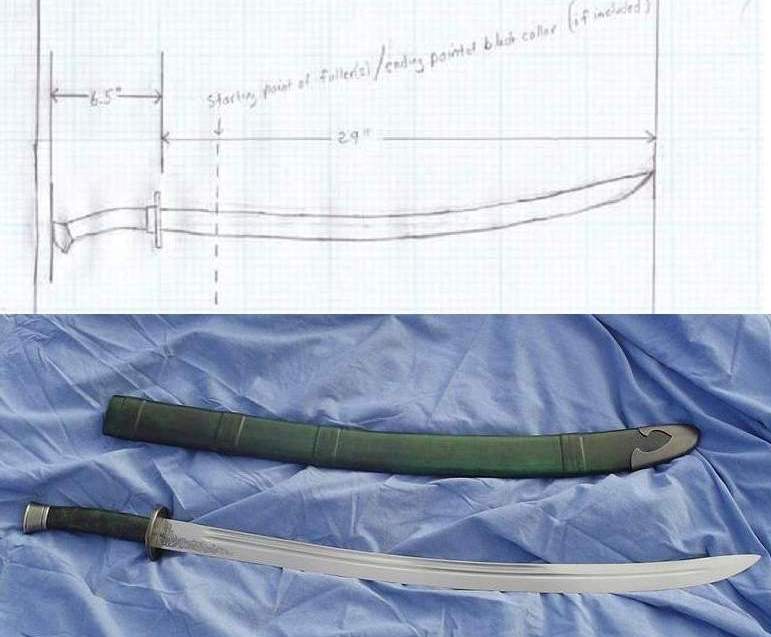 [img][/img] [img][/img]
|
|
   |
 |
|
Kevin Colwell
Industry Professional
Location: Connecticut Joined: 15 Dec 2011
Posts: 24
|
 Posted: Fri 02 May, 2014 8:44 pm Post subject: piandow Posted: Fri 02 May, 2014 8:44 pm Post subject: piandow |
 |
|
that is a lovely sword!
It appears to be well made, and a good product. Is it sanmei?
If there is a lower class, I am in it
If there is a criminal element, I am of it
If there is a soul in prison, I can not be free!
E V Debs
|
|
  |
 |
|
Stephen Curtin
|
 Posted: Sat 03 May, 2014 12:20 am Post subject: Posted: Sat 03 May, 2014 12:20 am Post subject: |
 |
|
Congrats on the new piece Chris. John did some beautiful work for you.
Éirinn go Brách
|
|
   |
 |
|
Chris Lampe
Location: United States Joined: 07 Mar 2005
Posts: 211
|
 Posted: Sat 03 May, 2014 11:47 am Post subject: Posted: Sat 03 May, 2014 11:47 am Post subject: |
 |
|
| Stephen Curtin wrote: | | Congrats on the new piece Chris. John did some beautiful work for you. |
This is a very old picture. I've been mostly out of the sword world for some time but I would say I had this sword made in the 2005-2006 timeframe. It was a fantastic sword that felt great in the hand. When my interests shifted to other things I sold it to a guy in Arizona. He was interested in having John make him a sword and he wanted to get an example in-hand before committing. He later mentioned that he loved this sword from the moment he took it out of the box so I know it went to a good home. I'm almost positive he went on to have John make him one or more custom swords.
The sword was one of the typical modern sword steels like 1075 or 5160. The fittings were mild steel, the grip burl wood and the scabbard leather covered wood. The blade was heat-treated to make it a useable sword (as are all swords John makes) and that back-edge was just as sharp as the true edge!
I've still got one of John's swords but this one I've vowed to take with me when I go. 
|
|
   |
 |
|
Timo Nieminen
|
 Posted: Sun 04 May, 2014 3:02 pm Post subject: Posted: Sun 04 May, 2014 3:02 pm Post subject: |
 |
|
A couple of Chinese falchions. Dao have a reputation as being brutal heavy choppers, and falchions have a reputation as being brutal heavy choppers. So, these being falchion-like dao, must be doubly brutal and heavy, surely? Alas, they don't live up to their reputation.
The top one is 850g, PoB at 5"/13cm, thin-bladed. The blade is 3.8mm at the thickest point, and 2.6mm at the flare. This is a slicer, not a chopper.
The bottom one is quite heavy, 1005g, PoB at 3.5"/8cm (which would come back a bit more with a grip). The blade is 6.2mm at the base, but thins quickly, and is fairly uniform along the mid-length, at 4.0mm in the middle, and 3.0mm at the flare. Again, a slicer. But a much heavier one than the top one.
 Attachment: 57.75 KB Attachment: 57.75 KB
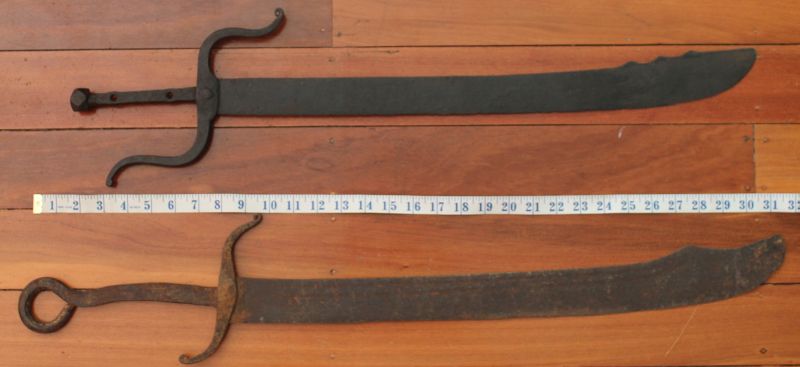
Falchion-like dao
"In addition to being efficient, all pole arms were quite nice to look at." - Cherney Berg, A hideous history of weapons, Collier 1963.
Last edited by Timo Nieminen on Sun 04 May, 2014 6:28 pm; edited 1 time in total
|
|
   |
 |
|
Timo Nieminen
|
 Posted: Sun 04 May, 2014 3:09 pm Post subject: Posted: Sun 04 May, 2014 3:09 pm Post subject: |
 |
|
Two more dao:
The top one is the right-hand member of a pair which would have sat in the same scabbard. The guard is riveted to the right hand side of the blade, and the grip slab is on the right. The rivets are flush on the left side, and there was no left side grip slab. 525g, PoB at 5"/13cm. The blade is fairly uniformly thick, with a maximum of 5.0mm, which is at a high spot, with most of the blade being at about 4.0mm
The bottom one is a straight dao. 655g, with the blade being 6.5mm at the base and tapered along its length to 5.5mm at mid-blade, and 3.7mm at the termination of the fuller near the tip. From spine to edge, the blade is wedge-section, except for the tip. Only about 1cm or so of the back edge of the spear point tip is sharpened. PoB is 6.5"/16.5cm.
 Attachment: 59.64 KB Attachment: 59.64 KB

Dao
"In addition to being efficient, all pole arms were quite nice to look at." - Cherney Berg, A hideous history of weapons, Collier 1963.
Last edited by Timo Nieminen on Sun 04 May, 2014 6:30 pm; edited 1 time in total
|
|
   |
 |
Michael Harley

Location: Melbourne, Australia Joined: 12 Apr 2006
Posts: 94
|
 Posted: Sun 04 May, 2014 4:03 pm Post subject: Posted: Sun 04 May, 2014 4:03 pm Post subject: |
 |
|
Timo, in the name of clarity, please pick one unit of length, either metric or imperial and stick with it. There is nothing more confusing than having dimensions of a single object being given in two completely different systems. Remember the Mars Climate Orbiter http://www.washingtonpost.com/wp-srv/national...100199.htm
Information is not knowledge, Knowledge is not wisdom, Wisdom is not truth - Frank Zappa
|
|
   |
 |
|
Timo Nieminen
|
 Posted: Sun 04 May, 2014 6:45 pm Post subject: Posted: Sun 04 May, 2014 6:45 pm Post subject: |
 |
|
Metric conversions added! IMO, inches make for a better visual scale than centimetres for sword-sized things. Centimetres are too small, and decimetres are too large. So I use an inch scale in the photos, which commits me to giving dimensions shown in the photos in inches. Otherwise, I use metric. Metric conversions for inches are easy, but I can provide if people need it.
Better than inches would be Japanese shaku and sun, Japanese feet and inches [1]. The Japanese foot is 303mm, and the division into smaller units is decimal, giving a 30.3mm "inch", the sun, which is a very good size for visual scales for swords. Alas, I don't have a shaku/sun tape measure or ruler with numbers on it. It has the added advantage of being equally unfamiliar to both imperial and metric unit users. (Chinese feet and inches would work, but, aside from joking about equal unfamiliarity, the closeness of the Japanese foot to the imperial foot gives it the advantage [2].)
(If you haven't found anything more confusing than the use of mixed unit systems, you're lucky; I, alas, run into lots of stuff that I find much more confusing.)
[1] http://en.wikipedia.org/wiki/Japanese_units_of_measurement
[2] http://en.wikipedia.org/wiki/Chinese_units_of...t#Length_2
"In addition to being efficient, all pole arms were quite nice to look at." - Cherney Berg, A hideous history of weapons, Collier 1963.
|
|
   |
 |
|
Timo Nieminen
|
 Posted: Tue 08 Sep, 2015 2:58 pm Post subject: Posted: Tue 08 Sep, 2015 2:58 pm Post subject: |
 |
|
Two reproduction/fake dao. The top one is recent, probably 5-10 years old. 1kg, 7.2mm thick at the guard, 4.2mm thick where the narrow fuller ends. The bottom one is a little older, and might even be late 20th century (but is probably 21st). 883g, 7.5mm thick at the guard, 4.5mm at the end of the fuller. Thins to 4mm about 7cm/3" from the tip.
 Attachment: 77.48 KB Attachment: 77.48 KB
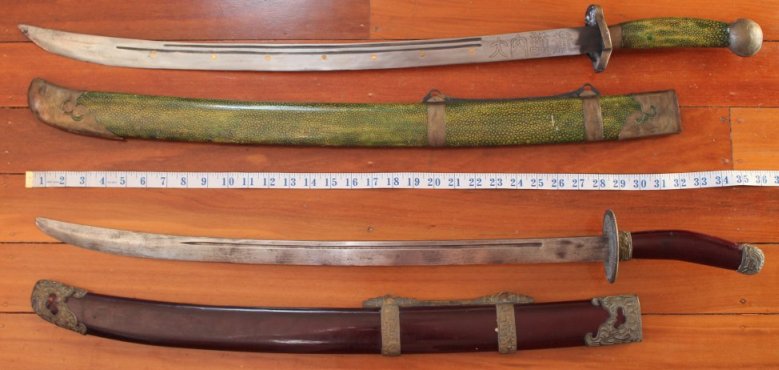
"In addition to being efficient, all pole arms were quite nice to look at." - Cherney Berg, A hideous history of weapons, Collier 1963.
|
|
   |
 |
|
|
You cannot post new topics in this forum
You cannot reply to topics in this forum
You cannot edit your posts in this forum
You cannot delete your posts in this forum
You cannot vote in polls in this forum
You cannot attach files in this forum
You can download files in this forum
|
All contents © Copyright 2003-2025 myArmoury.com — All rights reserved
Discussion forums powered by phpBB © The phpBB Group
Switch to the Basic Low-bandwidth Version of the forum
|

